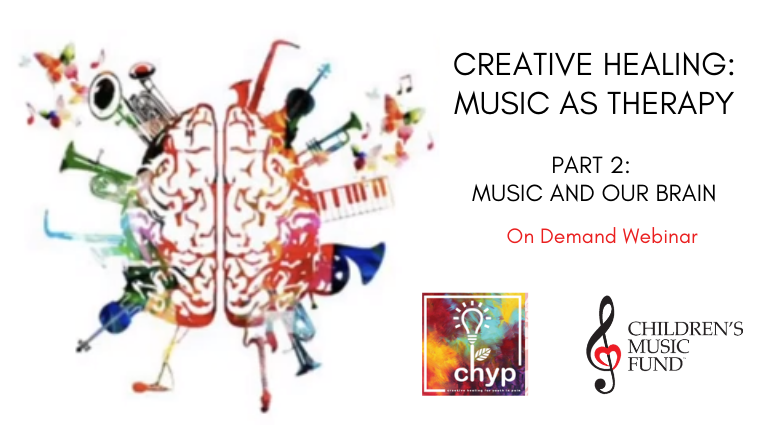
September 7, 2020 | Blogs and News
By Mireille Karadanaian — 1 min read —
Children’s Music Fund and Creative Healing for Youth in Pain (chyp) co-sponsored a panel discussion focusing on Music Therapy as a complement to medical treatments and how it can provide children with coping mechanisms for their chronic pain and illness. This is part two of our blog series featuring Dr. Talin Babikian’s commentary on music and our brains.
Why is Music Therapy so important? Dr. Babikian explained that music activates the limbic system, our reward center, and the frontal cortex of our brain. The limbic system is responsible for an individual’s ability to learn, retain memories, form emotional responses and find empathy — which is especially important during the grueling and difficult journey many hospitalized children face everyday.
Brain scans done during Music Therapy sessions reveal that music releases chemicals in the brain that play a significant role in altering our moods and feelings. These include dopamine and oxytocin, known to increase levels of motivation and movement for a child, and responsible for creating trust between individuals.
This is why a Music Therapist and a CMF child can form a profound connection while they sing and dance during their sessions. Additionally, hormones are released that affect and strengthen a sick child’s immune system and lower the sensitivity to pain.
Music Therapy offers assistance to a wide patient base by unlocking memories, reducing cognitive decline and aiding in social communication. This can provide boundless benefits to individuals with Autism or neuro-degeneritive diseases such as Parkinsons and Alzheimers. It helps patients find a community where they belong, as they combat their cognitive impairment. A branch of neuroscience known as neuroaesthetics showed that other than medical benefits, listening to self-selected music even improves one’s mood and mental health.
Outside of a clinical setting, music has been developmentally crucial, helping with the growth of motor, hearing, memory, verbal and literacy skills as well as math. The emphasis on introducing children to music at a young age has additional advantages, as playing and listening to music creates increased neural connections in the brain.
A study conducted by Harvard Medical School describes the process as a sort of “warm up” for the brain as it allows certain brain cells to process information much more efficiently. In this study, music was played for one group of patients undergoing surgery while the other group remained in silence during the procedure.
The results showed that the group with no music remained highly hypertensive during the surgery while the group exposed to music had significant reductions where the mean diastolic dropped down to 24 mm Hg for the lowest person. A mean blood pressure considered optimal during surgery is under 100 mm HG diastolic, which is why the results presented in the study are astounding and prove Music Therapy’s success in improving our mental and physical states of being.
Music is the glue for human connection, and has been a way of communication before words were ever spoken. Dr. Babikian says,
Language may individualize, but music harmonizes, it binds us all with it’s healing powers and universal voice.
The non-profit chyp works to help kids and their parents deal with chronic pain. There are a plethora of common healthcare barriers that individuals face on a daily basis, and chyp works to eliminate those by offering online resources that inspire strength, health and hope in the lives of today’s youth.
The non-profit Children’s Music Fund focuses on overcoming pain, fear and anxiety that children experience during hospitalization or treatment by allowing the power of Music Therapy to heal their mind, soul and body.
Watch our webinar to learn more about pain management and the benefits of Music Therapy for our youth and read the first blog in the series that discusses Creative Healing: Music As Therapy.
Keep informed about all the happenings at Children’s Music Fund by joining our mailing list, here.
